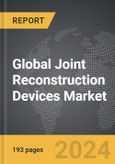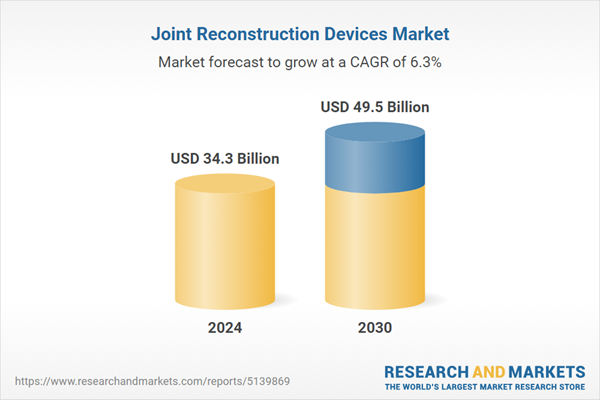The global market for Joint Reconstruction Devices was valued at US$34.3 Billion in 2024 and is projected to reach US$49.5 Billion by 2030, growing at a CAGR of 6.3% from 2024 to 2030. This comprehensive report provides an in-depth analysis of market trends, drivers, and forecasts, helping you make informed business decisions. The report includes the most recent global tariff developments and how they impact the Joint Reconstruction Devices market.
Segments: Segment (Knee Replacement, Hip Replacement, Trauma & Extremities).
Geographic Regions/Countries: World; United States; Canada; Japan; China; Europe (France; Germany; Italy; United Kingdom; Spain; Russia; and Rest of Europe); Asia-Pacific (Australia; India; South Korea; and Rest of Asia-Pacific); Latin America (Argentina; Brazil; Mexico; and Rest of Latin America); Middle East (Iran; Israel; Saudi Arabia; United Arab Emirates; and Rest of Middle East); and Africa.
The analysts continuously track trade developments worldwide, drawing insights from leading global economists and over 200 industry and policy institutions, including think tanks, trade organizations, and national economic advisory bodies. This intelligence is integrated into forecasting models to provide timely, data-driven analysis of emerging risks and opportunities.
Global Joint Reconstruction Devices Market - Key Trends & Growth Dynamics
Why Are Joint Reconstruction Devices Essential in Modern Orthopedic Care?
Joint reconstruction devices are critical in modern orthopedic care, offering solutions for patients suffering from severe joint pain, arthritis, and injury-related conditions. These devices, which include implants for hips, knees, shoulders, and other joints, help restore mobility, reduce pain, and improve the quality of life for millions of patients worldwide. The aging global population, coupled with the increasing prevalence of osteoarthritis and other degenerative joint diseases, is driving the demand for joint reconstruction procedures. Moreover, advancements in surgical techniques, such as minimally invasive surgery, are making these procedures safer and more effective, leading to better patient outcomes and faster recovery times.How Are Technological Advancements Enhancing Joint Reconstruction Devices?
Technological advancements are playing a pivotal role in enhancing the design and functionality of joint reconstruction devices. Innovations such as 3D printing, robotics, and advanced biomaterials are enabling the production of customized implants that are better suited to individual patient anatomies, improving the fit and performance of these devices. Additionally, the development of smart implants that can monitor joint health and provide real-time data to healthcare providers is revolutionizing post-operative care and long-term patient monitoring. These technological breakthroughs are not only improving the durability and functionality of joint reconstruction devices but also expanding their applications to younger and more active patients who require high-performance solutions.What Challenges Are Present in the Joint Reconstruction Devices Market?
The joint reconstruction devices market faces several challenges, including high costs, regulatory scrutiny, and the risk of implant failures. The cost of joint reconstruction surgery, particularly when advanced devices and techniques are used, can be prohibitive for many patients, especially in regions with limited healthcare access. Additionally, the market is subject to stringent regulatory requirements, as joint implants must meet rigorous safety and efficacy standards before they can be approved for use. Furthermore, despite advancements in technology, there is still a risk of implant failures or complications, which can result in the need for revision surgeries and impact patient outcomes. To address these challenges, manufacturers are focusing on improving the reliability of their devices, reducing costs through technological innovation, and ensuring compliance with regulatory standards through robust clinical testing.What Factors Are Driving Growth in the Joint Reconstruction Devices Market?
The growth in the joint reconstruction devices market is driven by several factors, including the increasing prevalence of joint disorders, the rising number of joint replacement surgeries, and continuous advancements in medical technology. The global aging population, combined with lifestyle factors such as obesity and physical inactivity, is contributing to a higher incidence of joint-related conditions, which in turn is boosting the demand for joint reconstruction procedures. Additionally, the ongoing development of innovative devices and surgical techniques is making joint reconstruction more accessible and effective, encouraging more patients to opt for these procedures. The expansion of healthcare infrastructure in emerging markets and the growing awareness of the benefits of joint replacement surgeries are also contributing to market growth, as more patients seek to improve their mobility and quality of life through these interventions.Report Scope
The report analyzes the Joint Reconstruction Devices market, presented in terms of units. The analysis covers the key segments and geographic regions outlined below.Segments: Segment (Knee Replacement, Hip Replacement, Trauma & Extremities).
Geographic Regions/Countries: World; United States; Canada; Japan; China; Europe (France; Germany; Italy; United Kingdom; Spain; Russia; and Rest of Europe); Asia-Pacific (Australia; India; South Korea; and Rest of Asia-Pacific); Latin America (Argentina; Brazil; Mexico; and Rest of Latin America); Middle East (Iran; Israel; Saudi Arabia; United Arab Emirates; and Rest of Middle East); and Africa.
Key Insights:
- Market Growth: Understand the significant growth trajectory of the Knee Replacement segment, which is expected to reach US$23.0 Billion by 2030 with a CAGR of a 6.6%. The Hip Replacement segment is also set to grow at 5.5% CAGR over the analysis period.
- Regional Analysis: Gain insights into the U.S. market, valued at $8.8 Billion in 2024, and China, forecasted to grow at an impressive 9.8% CAGR to reach $12.0 Billion by 2030. Discover growth trends in other key regions, including Japan, Canada, Germany, and the Asia-Pacific.
Why You Should Buy This Report:
- Detailed Market Analysis: Access a thorough analysis of the Global Joint Reconstruction Devices Market, covering all major geographic regions and market segments.
- Competitive Insights: Get an overview of the competitive landscape, including the market presence of major players across different geographies.
- Future Trends and Drivers: Understand the key trends and drivers shaping the future of the Global Joint Reconstruction Devices Market.
- Actionable Insights: Benefit from actionable insights that can help you identify new revenue opportunities and make strategic business decisions.
Key Questions Answered:
- How is the Global Joint Reconstruction Devices Market expected to evolve by 2030?
- What are the main drivers and restraints affecting the market?
- Which market segments will grow the most over the forecast period?
- How will market shares for different regions and segments change by 2030?
- Who are the leading players in the market, and what are their prospects?
Report Features:
- Comprehensive Market Data: Independent analysis of annual sales and market forecasts in US$ Million from 2024 to 2030.
- In-Depth Regional Analysis: Detailed insights into key markets, including the U.S., China, Japan, Canada, Europe, Asia-Pacific, Latin America, Middle East, and Africa.
- Company Profiles: Coverage of players such as B. Braun Melsungen AG, Johnson & Johnson, Smith & Nephew PLC, Stryker Corporation, Wright Medical Group NV and more.
- Complimentary Updates: Receive free report updates for one year to keep you informed of the latest market developments.
Some of the 43 companies featured in this Joint Reconstruction Devices market report include:
- B. Braun Melsungen AG
- Johnson & Johnson
- Smith & Nephew PLC
- Stryker Corporation
- Wright Medical Group NV
- Zimmer Biomet Holdings, Inc.
Tariff Impact Analysis: Key Insights for 2025
Global tariff negotiations across 180+ countries are reshaping supply chains, costs, and competitiveness. This report reflects the latest developments as of April 2025 and incorporates forward-looking insights into the market outlook.The analysts continuously track trade developments worldwide, drawing insights from leading global economists and over 200 industry and policy institutions, including think tanks, trade organizations, and national economic advisory bodies. This intelligence is integrated into forecasting models to provide timely, data-driven analysis of emerging risks and opportunities.
What’s Included in This Edition:
- Tariff-adjusted market forecasts by region and segment
- Analysis of cost and supply chain implications by sourcing and trade exposure
- Strategic insights into geographic shifts
Buyers receive a free July 2025 update with:
- Finalized tariff impacts and new trade agreement effects
- Updated projections reflecting global sourcing and cost shifts
- Expanded country-specific coverage across the industry
Table of Contents
I. METHODOLOGYII. EXECUTIVE SUMMARY2. FOCUS ON SELECT PLAYERSIII. MARKET ANALYSISIV. COMPETITION
1. MARKET OVERVIEW
3. MARKET TRENDS & DRIVERS
4. GLOBAL MARKET PERSPECTIVE
UNITED STATES
CANADA
JAPAN
CHINA
EUROPE
FRANCE
GERMANY
ITALY
UNITED KINGDOM
SPAIN
RUSSIA
REST OF EUROPE
ASIA-PACIFIC
AUSTRALIA
INDIA
SOUTH KOREA
REST OF ASIA-PACIFIC
LATIN AMERICA
ARGENTINA
BRAZIL
MEXICO
REST OF LATIN AMERICA
MIDDLE EAST
IRAN
ISRAEL
SAUDI ARABIA
UNITED ARAB EMIRATES
REST OF MIDDLE EAST
AFRICA
Companies Mentioned (Partial List)
A selection of companies mentioned in this report includes, but is not limited to:
- B. Braun Melsungen AG
- Johnson & Johnson
- Smith & Nephew PLC
- Stryker Corporation
- Wright Medical Group NV
- Zimmer Biomet Holdings, Inc.
Table Information
| Report Attribute | Details |
|---|---|
| No. of Pages | 193 |
| Published | April 2025 |
| Forecast Period | 2024 - 2030 |
| Estimated Market Value ( USD | $ 34.3 Billion |
| Forecasted Market Value ( USD | $ 49.5 Billion |
| Compound Annual Growth Rate | 6.3% |
| Regions Covered | Global |









